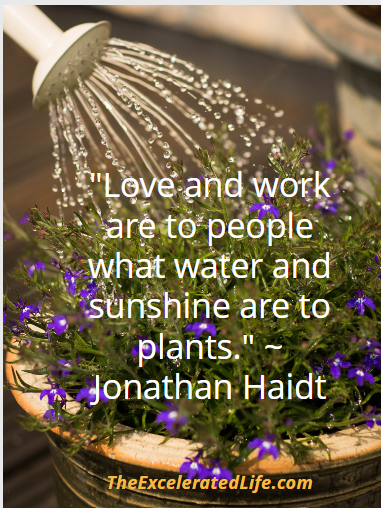When you are flourishing, you experience positive emotions, enjoy good health, physically and mentally, and have close, meaningful relationships with family and friends. Your life has meaning and you are living out your purpose. The good news is, by virtue of being human you contain within you the seeds of flourishing.
Flourishing, An Example
Today, I want to introduce you to two friends, Alex and Alice. Both have recently retired and are faced with creating a new and different phase of life. Let’s take a look and see how it’s going.
First, here’s Alex. Alex spent the majority of his time at work. He had advanced to upper management and, frankly, hadn’t thought much about retirement. Then, he was “asked” to retire when his company downsized.
Because his life revolved around his job, Alex has no real ties to others and not many outside interests. Oh, there’s the occasional golf outing or college football game, but he has no hobbies or other activities outside of work. He just “didn’t have time”.
Now, Alex doesn’t know what to do with himself. He is not looking forward to the future with hope. Oh, he and the wife might travel a little, visit children and grandkids, but, if truth be told, he doesn’t know his family that well because he was rarely available to spend time with them.
All in all, Alex is floundering a bit.

Now, meet Alice. Alice had an active and successful career but it wasn’t her only focus. She had thought ahead to retirement, so when she was caught up in the company downsizing, she was OK about it.
Alice has held various volunteer positions over the years and has ties to a number of nonprofit agencies in the community. She has cultivated strong friendships with a few people and they continue to enjoy taking trips, seeing shows and visiting interesting places. She also has close ties to her family, her children and grandchildren.
Alice feels capable and in control of her future. In short, Alice is flourishing.
What Is Human Flourishing?
When we examine it, we find there are a number of components to human flourishing. Flourishing includes experiencing positive emotions, positive psychological functioning, and positive social interactions. [“Flourishing.”] It means much more than simply being happy and “offers a more holistic perspective”. [Ackerman]
It is also important to consider that, while there are certain universal properties that are components of human flourishing, there are also pieces that are different for each individual. This makes flourishing and specific aspects of flourishing always uniquely personal. [Younkins]
“To seek a good human life,” writes Edward W. Younkins, “is to seek self-fulfillment through the actualization of one’s potentialities, personal endowments, and energies.” [Younkins] That is flourishing.
Flourishing and Happiness
Human flourishing can be equated to “complete human well-being.” [“Five Domains for Human Flourishing.”] A working definition of flourishing could be “living in a state in which all aspects of a person’s life are good.” [“Five Domains for Human Flourishing.”]
But “good” is too broad and nebulous and can mean different things to different people or cultures. So the Human Flourishing Program at Harvard identified some specific domains to examine. [“Five Domains for Human Flourishing.”] We can use these as we think about our own flourishing.
- Happiness and life satisfaction
- Meaning and purpose
- Character and virtue
- Close social relationships
Components of Flourishing
When we examine the work that has been done over the past several years, particularly among positive psychologists, to study what flourishing is and how we can flourish, we find that the components of flourishing include multiple concepts like learning and using our strengths, subjective well-being (or how people experience and evaluate their lives), goodness, growth, and resilience. [“Flourishing.”]
In addition to these individual aspects, it also includes “many applications to civic duty and social engagement.” [“Flourishing.”]
We can’t discuss the components of flourishing without including Dr. Martin Seligman’s PERMA model of well-being.
The five factors in this model are:
- Positive emotions
- Engagement
- Relationships
- Meaning
- Accomplishments
[Seligman 1]
We might see flourishing as “the state that we create when we tend to each aspect of the PERMA model”. [Ackerman]
Actions for Flourishing
As we’ve seen, flourishing includes happiness, well-being, growth, resiliency, and life satisfaction, as well as social and civic engagement. There are likely also individual components that are unique to each person.
Some researchers have proposed that there may be other components of flourishing, such as virtue, health, financial stability, and spiritual growth. [Ackerman] As we seek to find ways to improve and increase our own ways to flourish, it may be productive to keep these in mind as well.
We must also acknowledge that flourishing isn’t like a talent or trait, it isn’t something you either have or you don’t. [Ackerman] It’s something you do, not something you are. Any of us can do it, but it takes a certain amount of effort to get there.
Qualities for Building Flourishing
Writing for the Positive Psychology website, Courtney E. Ackerman identifies five qualities [Ackerman] that distinguish those who are flourishing from those who are not. (Remember Alex and Alice?) Check yourself against this list and see where you stand.
Pay attention to what you pay attention to. Just as we manage our resources of time, energy, and money, we ought to carefully manage our attention and where we give it. Are you focused on things you can’t control and getting angry, worried, or sad? Or do you focus your attention on the things you can control, like your response to the things that happen?
Manage your time. Linked to where we put our attention is how we spend our time. We all have time constraints to deal with. (You’ll never have time to do everything you have to do, remember?) But you can learn to focus your time on the most important things (to you), the high-value tasks that lead you closer to your goals.
Practice kaizen – continuous improvement. As we noted above, flourishing is not something you either are or aren’t. It’s something you do. And you do it by identifying small ways to develop and grow and improve – and then doing them.
Ask for feedback and listen. The ability to flourish requires that we ask for feedback on our behavior and performance. It’s hard for us to objectively evaluate ourselves, so getting the opinion and viewpoints of trusted people is important. People who flourish are open to advice and are willing to listen to and learn from other people.
Commit to seeking out positive experiences. Review Martin Seligman’s PERMA model of well-being and evaluate yourself in the five areas: positive emotions, engagement, relationships, meaning, and accomplishments. People who flourish pay attention to these areas and find ways to engage with them.
As you peruse this list, perhaps you see some areas where you could improve and flourish even more!

Steps to Flourishing
Here are steps you and I can take to move from languishing to flourishing . . . or to flourish even more. [Ackerman]
- Develop your social support system. Find new friends and find ways to deepen relationships with your spouse or significant other, your family, and your friends.
- Find “the good” in your life. Acknowledge and celebrate the meaningful or exciting events in your life. Take time to savor the fulfilling and enjoyable things that you engage in.
- Have more fun. Find ways to enjoy the pleasures of life. Plan a vacation; go out to a new restaurant; schedule that exciting adventure you’ve always wanted to try.
- Live on purpose. If you haven’t discovered your purpose yet, no worries. Try this exercise to help you do that. Then decide upon one small or big thing you can do every day to help you live out your purpose.
Where Do I Go From Here?
Here is an exercise to help you increase your ability to flourish.
- Take the Diener Flourishing Scale assessment and record your score.
- Each day for the coming week, commit to doing one activity from the above list (or use your own ideas) and then do it.
- After a week, re-visit the flourishing scale. Did your score increase?
Do this exercise as often as you wish to improve your ability to flourish.
Future Forcast: Flourishing [1]
“Do you have enough positivity to pull off the age-old recipe for a flourishing life? If you find yourself short, you can surely gather up more. After all, simply by being human, you have within you the seeds of flourishing.” [Fredrickson]
Stop for a moment and let that sink in. By virtue of being human, you contain within you the seeds of flourishing. Let us nurture those seeds and watch them – and us – flourish.
As Dr. Martin Seligman, the “father of Positive Psychology” says: [Seligman 2]
- “We can all say “Yes” to more positive emotion in life.”
- “We can all say “Yes” to more engagement with the people we love, in our work, in our leisure.”
- “We can all say “Yes” to better relationships with people.”
- “We can all say “Yes” to more meaning in life.”
- “We can all say “Yes” to more positive accomplishment.”
- “We can all say “Yes” to human flourishing.”
Say “Yes” to the components of flourishing. Say “Yes” to embracing your Excelerated Life™!
Where are you flourishing?
Where could you do more?
Share your comments by leaving a post below.
Excelerated Positivity™ — building the skills that help you flourish — is one step in creating your Excelerated Life™, a life of flourishing and well-being, and a life of meaning, purpose, and service.
Read more about the Excelerated Life™.
Footnotes:
[1] This is the title of the final chapter in Barbara Fredrickson’s book, i-Positivity. See resources.
Resources:
Ackerman, MSc., Courtney E. “What Is Flourishing in Positive Psychology?” PositivePsychology.com. PositivePsychology.com., May 9, 2018. Web. October 1, 2022.
https://positivepsychology.com/flourishing/
“Five Domains for Human Flourishing.” Templeton World. A Medium Corporation, Sep 24, 2020. Web. October 1, 2022.
https://medium.com/templeton-world/five-domains-for-human-flourishing-f11fd2330c95
“Flourishing.” en.wikipedia.org. Wikimedia Foundation, Inc., August 25, 2022. Web. October 1, 2022.
https://en.wikipedia.org/wiki/Flourishing
Fredrickson, Ph.D., Barbara, L. Positivity. New York: Crown Publishing Group, 2009.
Seligman, Ph.D., Martin E. P. Flourish. New York: Free Press, 2011.
Seligman, PhD, Martin. “Flourish: Positive Psychology and Positive Interventions.” October 7, 2010. PDF file.
https://tannerlectures.utah.edu/_resources/documents/a-to-z/s/Seligman_10.pdf
Younkins, Edward W. “Human Nature, Flourishing, and Happiness: Toward a Synthesis of Aristotelianism, Austrian Economics, Positive Psychology, and Ayn Rand’s Objectivism.” Libertarian Papers 2, no. 35 (2010): 1–50.


